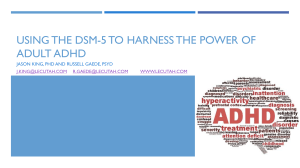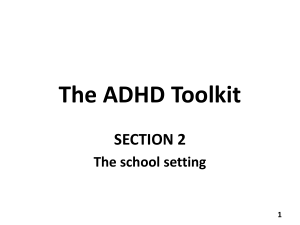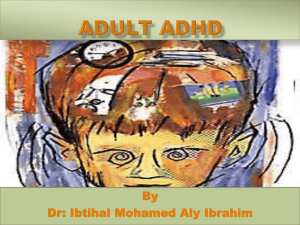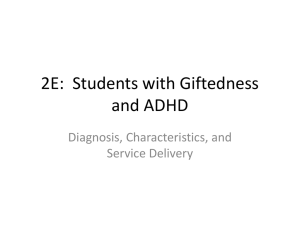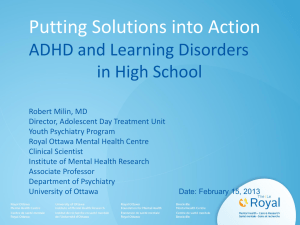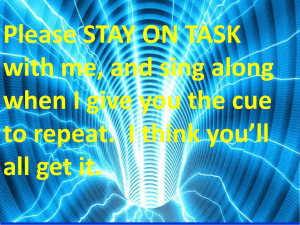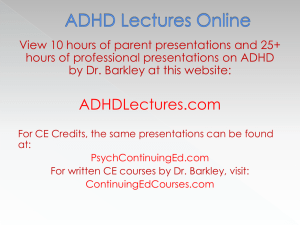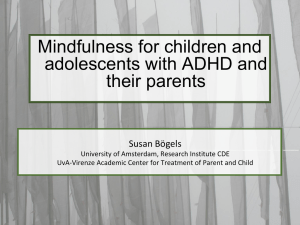HYPERACTIVITY DISORDER (ADHD)
advertisement
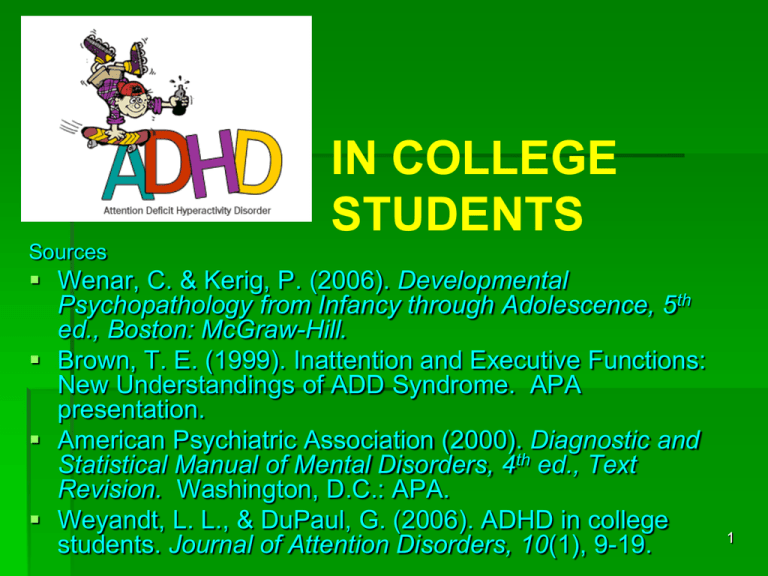
IN COLLEGE STUDENTS Sources Wenar, C. & Kerig, P. (2006). Developmental Psychopathology from Infancy through Adolescence, 5th ed., Boston: McGraw-Hill. Brown, T. E. (1999). Inattention and Executive Functions: New Understandings of ADD Syndrome. APA presentation. American Psychiatric Association (2000). Diagnostic and Statistical Manual of Mental Disorders, 4th ed., Text Revision. Washington, D.C.: APA. Weyandt, L. L., & DuPaul, G. (2006). ADHD in college students. Journal of Attention Disorders, 10(1), 9-19. 1 A quick self-assessment Please take out a piece of paper. Following are 6 statements describing behaviors or difficulties that people sometimes have. For each one, please write down the number that indicates how often you have noticed that behavior or difficulty in yourself IN THE LAST SIX MONTHS. (based on ASRS WHO screener, from Kessler et al., 2005) 2 NEVER 0 RARELY 1 SOMETIMES 2 OFTEN 3 VERY OFTEN 4 1) How often do you have trouble wrapping up the fine details of a project, once the challenging parts have been done? 2) How often do you have difficulty getting things in order when you have to do a task that requires organization? 3) When you have a task that requires a lot of thought, how often do you avoid or delay getting started? 3 NEVER 0 RARELY 1 SOMETIMES 2 OFTEN 3 VERY OFTEN 4 4) How often do you have problems remembering appointments or obligations? 5) How often do you fidget or squirm with your hands or your feet when you have to sit down for a long time? 6) 6) How often do you feel overly active and compelled to do things, like you were driven by a motor? 4 Scoring the ASRS A total of 11 or higher MAY BE consistent with adult ADHD NOTE: There is much more to diagnosis than this – many things can affect the scores 5 Diagnosing ATTENTION-DEFICIT/ HYPERACTIVITY DISORDER (ADHD) DSM-IV-TR (the Diagnostic and Statistical Manual of Mental Disorders) delineates 3 types of ADHD 1. hyperactive-impulsive type 2. inattentive type 3. combined type 6 DSM-IV-TR criteria for inattentive type (6 or more of these for at least 6 mos. to a degree that is maladaptive and inconsistent with developmental level) difficulty sustaining attention careless mistakes on schoolwork failure to complete tasks does not seem to listen when spoken to directly difficulty organizing reluctance to do things that require sustained mental effort forgetfulness loses things 7 easily distracted DSM-IV-TR criteria for hyperactivity/impulsivity (6 or more for at least 6 mos. to a degree that is maladaptive and inconsistent with developmental level) hyperactivity often fidgets and squirms leaves seat frequently runs or climbs excessively and inappropriately difficulty playing quietly excessive activity, as if “driven by a motor” excessive talking often blurts out answers has difficulty awaiting turn frequently interrupts others impulsivity 8 9 BUT there’s more to the story: the day-to-day realities of living with ADHD Features associated with ADHD (often, though not always, present) DIFFICULT BEHAVIOR temper outbursts bossy demanding stubborn 10 More associated features NEGATIVE FEELINGS changeable moods angry, frustrated sad, demoralized poor self-esteem resentful 11 More associated features SOCIAL rejection by others seen as lazy, irresponsible, difficult, disobedient 12 More associated features ACHIEVEMENT/ OCCUPATIONAL poor achievement/ don’t apply self finish fewer years of school poor vocational adjustment lower IQ scores 13 The Development of ADHD Tends to emerge in preschool and early school years, as children’s natural curiosity is channeled into learning specific subjects in a structured academic setting Prevalence for school-age children: 3 to 7 % Prevalence for college students: not well understood estimates range from 2% to 8% 14 Significant COMORBIDITY Disruptive behavior (oppositional defiant disorder, conduct disorder) Strong association -maybe 50%! When CD and ADHD coexist, more serious disturbance, more depression, more substance abuse & adult criminal activity 15 Comorbidity (continued) ANXIETY in 10-40% of clinical population with ADHD More likely with inattentive-type. BUT anxiety tends to diminish intensity of ADHD symptoms! Also, IMPORTANT to assess for presence of trauma (PTSD symptoms can resemble ADHD, but treatment interventions very 16 different) COMORBIDITY (continued) Mood disorders 20-30% (depression, bipolar disorder) BUT this may be related more to CD ALSO symptoms of ADHD overlap to some extent with bipolar disorder Learning Disorders 19-26% BUT maybe 80% have significant learning problems Also, an array of developmental problems – motor, cognitive, emotional, and social. These complicate the picture and increase the risk of other psychopathology 17 ADHD in adults Less well researched, and less understood Persists for about 50% of individuals Significant impairment, yet often not recognized as ADHD ADHD is more difficult to detect in adults, 18 FROM http://adderallxronline.com/adult_adhd/undiagnosed_adhd/might_have_adhd.asp 20 ADHD in college students Again, not well researched or well understood Between 2 and 8% of college students report clinically significant symptoms Greater risk of academic difficulties May be greater risk of psychological problems as well 21 ADHD in college students Increasingly, requesting accommodations Most often, extra time on tests and separate testing rooms Often comorbid with other difficulties, esp. learning disorders 22 Problems of college students with ADHD Preliminary studies suggest: Lower GPA, more academic problems Impaired organizational skills Procrastination Study skill deficits 23 Problems of college students with ADHD (continued) Deficits in self-control and selfmanagement Inner restlessness, intrusive and off-task thoughts Psychological distress Interpersonal difficulties 24 Resources at Shepherd University Shepherd University Disability Support Services -- Christana Johnson: (304) 876-5453 TRIO Student Support Services -- Cynthia Copney: (304) 876- 5779 Counseling Services (304) 876-5276 Academic Support Center (304) 876-5221 Dr. Anne Murtagh, Psychology (304) 876-5257 25

